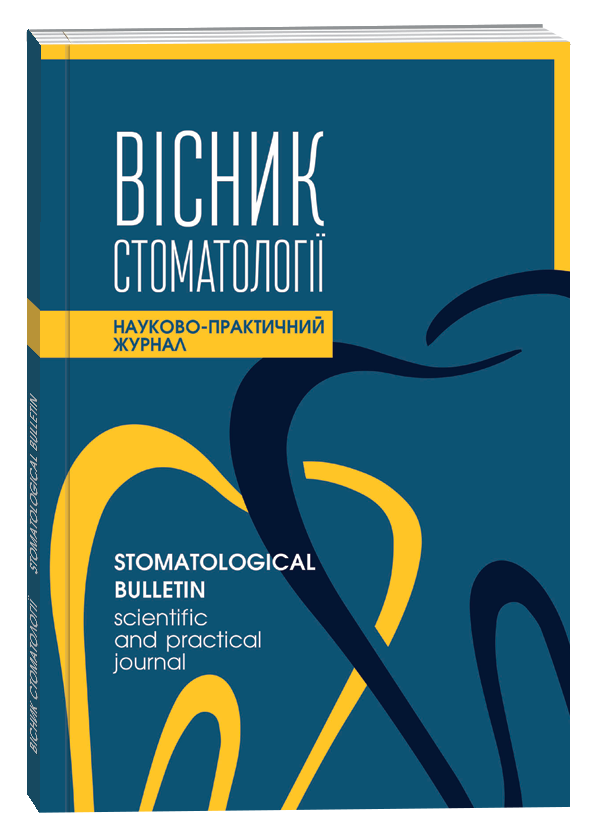FEATURES OF THE ASSOCIATION OF PATHOLOGY OF THE ENT ORGANS WITH DENTAL ANOMALIES AND DEFORMITIES IN PEDIATRIC PATIENTS
DOI:
https://doi.org/10.35220/2078-8916-2022-44-2.13Keywords:
narrowing of the upper jaw, dental deformities, ENT pathology, orthodontic treatment.Abstract
The purpose of the study is study of the association of ENT pathology with dental anomalies and deformities in pediatric patients, and increase the effectiveness of diagnosis and orthodontic treatment of patients with narrowing of the dentition. Research methods. We examined 239 children with dental anomalies, aged 6–18 years, in order to identify their combination with nasal breathing disorders and ENT pathology. For a comprehensive justification of the proposed treatment was selected and examined 85 people with narrowing of the jaw, which depending on age, sex, the presence of ENT pathology were divided into three groups: Group I – 30 patients with narrowing of the upper jaw without nasal breathing disorders and ENT – pathologies, which carried out conventional treatment. The second group included 30 patients with narrowing of the upper jaw, nasal breathing disorders and ENT – pathology, who received conventional treatment. The third group included 25 patients with narrowing of the upper jaw, nasal breathing disorders and ENT – pathology, which was treated by the proposed method. Depending on age, each of the groups was divided into three subgroups: A – patients from 6 to 9 years, B – from 10 to 14 years, C – from 15 to 18 years. Scientific novelty. The prevalence of dental anomalies in children of different age groups and their combination with nasal breathing disorders and ENT pathology have been studied. A comprehensive method of treatment of patients with upper jaw narrowing and ENT diseases with the use of surgical and orthodontic methods, which eliminates the cause of abnormalities of the dental system and achieve positive long-term treatment results. Scientific results have been obtained that the proposed orthodontic treatment significantly improves the clinical indices of the depth of the arch of the palate in 2 months after fixation of the orthodontic appliance, immediately after removal and 6 months after removal of the orthodontic appliance. Conclusions. The application of the proposed method of complex diagnosis and treatment of patients with narrowing of the upper jaw and ENT pathology in variable occlusion allows to obtain significantly better (p<0.05) indicators of the depth of the palate after treatment, compared with pre-treatment.
References
Хорошилкина Ф. Я. Ортодонтія. Москва, 2010. 592 с.
Дмитренко М. І. Особливості комплексної діагностики пацієнтів із зубощелепними аномаліями, ускладненими скупченістю зубів. Вестник проблем биологии и медицины. 2016; 2 (1). 232–235.
Наврузов К. Т. Изучение влияния затрудненного носового дыхания на рост и развитие зубочелюстно- лицевой системы у детей. Российская ринологія. 2011. № 1. С. 16.
Evaluation of the effectiveness of a semi-finished occlusal appliance-a randomized, controlled clinical trail. Ficnar T., Middelberg С., Rademacher B. et al. Head Face Med. 2013; 5. P. 5–9.
Treatment of obstructive sleep apnea syndrome by rapid maxillary exspansion. P. A. Cistulli, R. G. Palmisano, M. D. Poole. Sleep. 2011. Vol. 21, № 8. P. 831–835.
Prevalence and distribution of dental anomalies: a comparison between maxillary and mandibular tooth agenesis. Al-Abdallah M., AlHadidi A., Hammad M. et al. Am J Orthod Dentofacial Orthop. 2015; 148 (5): 793–798.
Alexander ‘Wick’ R. G. ‘Wick’ Alexander. – Quintessence Publishing Co Inc., U. S., 2013. 1740 р.









